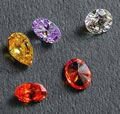 Cubic Zirconia is well known as a substitute for diamond, due to its high hardness and great fire. But in recent years, it has established itself as a gorgeous gem in its own right. CZ is a beautiful synthetic gemstone that is durable and inexpensive and now even comes in any color of the rainbow, making it even more desirable.
Cubic Zirconia is well known as a substitute for diamond, due to its high hardness and great fire. But in recent years, it has established itself as a gorgeous gem in its own right. CZ is a beautiful synthetic gemstone that is durable and inexpensive and now even comes in any color of the rainbow, making it even more desirable.
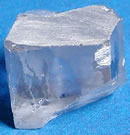 Cubic Zirconia is a cubic form of zirconium oxide that is created in a laboratory, thus it is not a mineral. However, it was found naturally occurring once at one site in the 1930’s, but has yet to be discovered since then. The mineral with the same chemical composition as CZ, but in the monoclinic crystal system, is baddeleyite.
Cubic Zirconia is a cubic form of zirconium oxide that is created in a laboratory, thus it is not a mineral. However, it was found naturally occurring once at one site in the 1930’s, but has yet to be discovered since then. The mineral with the same chemical composition as CZ, but in the monoclinic crystal system, is baddeleyite.
 Synthesized zirconium oxide, cubic zirconia, is hard (8.5 on Mohr’s Scale of Hardness), optically flawless and usually colorless, but may be produced with a variety of different colors. The refractive index of CZ is between 2.088 and 2.176, which is very high. Since CZ is transparent, it is often faceted. It can be made in nearly any color and can be faceted into many cuts. Because of its low cost, durability, and close visual likeness to diamond, synthetic cubic zirconia has remained an important diamond simulant since 1976.
Synthesized zirconium oxide, cubic zirconia, is hard (8.5 on Mohr’s Scale of Hardness), optically flawless and usually colorless, but may be produced with a variety of different colors. The refractive index of CZ is between 2.088 and 2.176, which is very high. Since CZ is transparent, it is often faceted. It can be made in nearly any color and can be faceted into many cuts. Because of its low cost, durability, and close visual likeness to diamond, synthetic cubic zirconia has remained an important diamond simulant since 1976.
To produce CZ, baddeleyite (ZrO2 ) is heated to about 2300 degrees Celsius (almost 5,000 degrees Fahrenheit). This causes the mineral to become isometric. However, this change is not permanent, it reverses upon cooling; which is why a stabilizer must be added to prevent transformation upon cooling. If too much stabilizer is added, it results in a softer, less brilliant product. This requires such high heat that a special radio frequency “skull crucible” must be used to melt the zirconia powder. As the zirconia melts, it leaves a thin shell that remains solid because it is cooled by the water in the copper fingers. As this occurs the zirconia and the stabilizing oxide are added to fill the skull the desired level. The contents are kept molten for several hours to ensure uniformity.
 To produce colors, oxides of cerium, copper, titanium, iron, nickel, and many other elements are added also.
To produce colors, oxides of cerium, copper, titanium, iron, nickel, and many other elements are added also.
History
Cubic Zirconia was discovered in its natural state in 1937 by two German mineralogists, von Stackelberg and Chudoba. It was in a highly metamict zircon given to them by B.W. Anderson. The zircon contained tiny crystals that were determined to be the cubic form of zirconium oxide by x-ray diffraction. The two mineralogists thought so little of their discovery that they did not even give it a name; which is why it is still known by its scientific name, cubic zirconia.
 It wasn’t until the 1970’s, however, that Soviet scientists learned how to grow the crystals in the laboratory. In 1977, it was first marketed under the trade name “Djevalite.” But CZ really took off in the 1980’s when Swarovski & Co., a world-renowned Australian producer of leaded crystal, began producing cubic zirconia for mass consumption.
It wasn’t until the 1970’s, however, that Soviet scientists learned how to grow the crystals in the laboratory. In 1977, it was first marketed under the trade name “Djevalite.” But CZ really took off in the 1980’s when Swarovski & Co., a world-renowned Australian producer of leaded crystal, began producing cubic zirconia for mass consumption.
Caring for CZ
Cubic zirconia can be cleaned with any conventional jewelry cleaner or detergent. With such a high hardness and durability, you can use a brush to clean off dirt or oil also. Ultra sonic jewelry cleaners may also be used on CZ and will not damage the stone. However, when using soaps or detergents to clean CZ, one should wipe the jewelry dry thoroughly to avoid residue from the soap leaving a film that will dull the brilliance of the stone. Cubic Zirconia should be cleaned frequently to remove oils from skin that also dull the brilliance of the gem.
Compared to Diamond
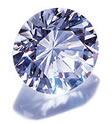 To the untrained eye, cubic zirconia looks very similar to a good quality diamond, but CZ has slightly less brilliance or sparkle than a diamond and more fire or flashes of color. The overall visual effect is so similar that it can even fool a trained gemologist on occasion, but other tests can easily differentiate cubic zirconia from diamond.
To the untrained eye, cubic zirconia looks very similar to a good quality diamond, but CZ has slightly less brilliance or sparkle than a diamond and more fire or flashes of color. The overall visual effect is so similar that it can even fool a trained gemologist on occasion, but other tests can easily differentiate cubic zirconia from diamond.
One great difference between cubic zirconia and diamond is weight; CZ is about 60% heavier than diamond. A piece of CZ the same size as a one carat diamond weighs about 1.6 carats.
 CZ is also more brittle than diamond and softer. A cubic zirconia can be scratched by diamond, topaz, ruby or sapphire whereas a diamond can only be scratched by another diamond.
CZ is also more brittle than diamond and softer. A cubic zirconia can be scratched by diamond, topaz, ruby or sapphire whereas a diamond can only be scratched by another diamond.
Cubic Zirconia is also flawless, whereas diamond usually contains impurities and inclusions. A colorless diamond with flawless clarity is extremely rare. On the other hand, most cubic zirconia is perfectly transparent and flawless under 10x magnification. One of cubic zirconia’s shortcoming as a diamond simulant is that it is too perfect.
Asha®
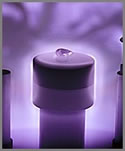 Asha® is a branded form of cubic zirconia and is advertised as the only diamond simulant in the world that employs a patent pending form of “Amorphous Diamond” which is man-made and “composed of a multitude of tiny diamond crystals all aligned together.” These microscopic diamond crystals are blasted into the Asha® crystal through the Amorphous Diamond Treatment (ADT) process to give Asha® an upper layer that is both simulant and man-made diamond crystal. They describe this process as being “Diamond Infused”, as atomic force microscope analysis shows that the microscopic diamond crystals literally penetrate into the upper layers of the Asha® crystal, to form a new hybrid diamond simulant.
Asha® is a branded form of cubic zirconia and is advertised as the only diamond simulant in the world that employs a patent pending form of “Amorphous Diamond” which is man-made and “composed of a multitude of tiny diamond crystals all aligned together.” These microscopic diamond crystals are blasted into the Asha® crystal through the Amorphous Diamond Treatment (ADT) process to give Asha® an upper layer that is both simulant and man-made diamond crystal. They describe this process as being “Diamond Infused”, as atomic force microscope analysis shows that the microscopic diamond crystals literally penetrate into the upper layers of the Asha® crystal, to form a new hybrid diamond simulant.
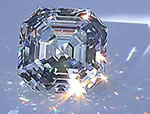 Asha® has a marketing strategy of trying to pointing out its advantages over Moissanite. They note that Moissanite, in its natural state, is a green stone. The synthetic moissanite manufacturers try to remove the green in order to get it to appear more diamond-like in color, but they still have a ways to go! They also note, that in daylight, moissanite tends to ‘fluoresce’ green whereas Asha® crystals tend to be higher color than Moissanite.
Asha® has a marketing strategy of trying to pointing out its advantages over Moissanite. They note that Moissanite, in its natural state, is a green stone. The synthetic moissanite manufacturers try to remove the green in order to get it to appear more diamond-like in color, but they still have a ways to go! They also note, that in daylight, moissanite tends to ‘fluoresce’ green whereas Asha® crystals tend to be higher color than Moissanite.
A gem quality diamond will exhibit a crisp, clear look to it. This is because its internal crystal structure is face-centered-cubic. By comparison, Moissanite is hexagonal which means that it will not handle light the way a diamond does, and creates what is termed “bi-refringance”. Basically, light waves are split inside the crystal and their velocity becomes unequal, thus things appear doubled in appearance. The end result is that Moissanite does not look like a diamond when examined closely. Instead, it will appear fuzzy or blurry to the eye. By comparison, Asha® perfectly mimics the diamonds crystal structure (face-centered-cubic) resulting in a virtually identical look as fine diamond.
Asha® also points out that Moissanite is not cut like a diamond is: Because Moissanite has a different crystal structure, it is cut to a different style than diamond to try and optimize its particular strengths. However, the different cut is also a key to the knowledgeable observer that it is not a diamond. By comparison, Asha® tends to be hand-cut to the highest diamond specifications possible (Hearts and Arrows), something which very few diamonds in fact will achieve (but they all strive for).
Learn more about Asha branded cubic zirconia at BetterThanDiamond.com
CARAT*™
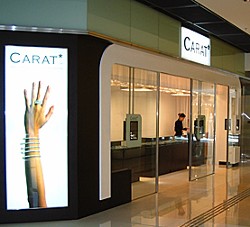 Headquartered in London, CARAT*™ is a brand of cubic zirconia produced by the CARAT*™ company with store locations in Hong Kong, Macau, United Kingdom, Ireland, Japan, Australia, and United States. CARAT*™ jewelry items are also available online with prices ranging from about $280 for a 1 carat (equivalent diamond size) to about $375 for a 3.5 carat (equivalent diamond size) stone.
Headquartered in London, CARAT*™ is a brand of cubic zirconia produced by the CARAT*™ company with store locations in Hong Kong, Macau, United Kingdom, Ireland, Japan, Australia, and United States. CARAT*™ jewelry items are also available online with prices ranging from about $280 for a 1 carat (equivalent diamond size) to about $375 for a 3.5 carat (equivalent diamond size) stone.
The marketing for CARAT*™ is less diamond bashing than other brands and focuses more on the fashion aspect of their jewelry. The advertising is very up front about their product being a diamond simulant and even has a section titled “About Fake Diamonds.” They differentiate themselves from standard CZ by saying they use higher quality materials, superior cutting techniques, and better quality control.
It is refreshing to see a diamond simulant company confident enough about their product that they do not have to rely on diamond industry bashing and misleading comparisons to diamonds to attract their customers.
Diamond Nexus
![]() Diamond Nexus Labs (DNL), a company located in Franklin, Wisconsin, produces a cubic zirconia brand that they market as the “World’s Finest Diamond-Simulant Gemstones.” Their marketing relies heavily on negative advertising techniques with phrases like “DeBeers Diamond Cartel has had a stranglehold on the production of mined diamonds. Their sometimes brutal business practices and strong-arm tactics intended to control and inflate diamond prices” or “No secret minded diamond dirty tricks and scams.” This is ironic since the name of the company, Diamond Nexus Lab, and they position every aspect of their marketing to imply their product is somehow related to a diamond.
Diamond Nexus Labs (DNL), a company located in Franklin, Wisconsin, produces a cubic zirconia brand that they market as the “World’s Finest Diamond-Simulant Gemstones.” Their marketing relies heavily on negative advertising techniques with phrases like “DeBeers Diamond Cartel has had a stranglehold on the production of mined diamonds. Their sometimes brutal business practices and strong-arm tactics intended to control and inflate diamond prices” or “No secret minded diamond dirty tricks and scams.” This is ironic since the name of the company, Diamond Nexus Lab, and they position every aspect of their marketing to imply their product is somehow related to a diamond.
It appears Diamond Nexus Labs products are only sold online with a network of websites, that at first glance appear to be customer reviews, industry reviews, and blogger comments on the product, but are really websites supported by the DNL company. The online hype allows DNL to sell their brand of cubic zirconia at a high multiple over the price of generic cubic zirconia. While the Diamond Nexus Labs website highlights its Information and Education Center, I challenge you to find the term “cubic zirconia” on their website.
The Diamond Nexus Labs stones are sold in a variety of loose shapes as well as in jewelry items. DNL only advertises white stones on their website and the price is about $100 per carat for loose stones.
Diamonique
![]() Diamonique® is a registered trade mark, belonging to QVC Inc., and the brand name they choose to use for cubic zirconia, a diamond simulant. QVC markets Diamonique as the “finest simulated gemstone made by man” but they never make mention that it is cubic zirconia. If fact, a search for “cubic zirconia” on the QVC.com website shows no match for that term.
Diamonique® is a registered trade mark, belonging to QVC Inc., and the brand name they choose to use for cubic zirconia, a diamond simulant. QVC markets Diamonique as the “finest simulated gemstone made by man” but they never make mention that it is cubic zirconia. If fact, a search for “cubic zirconia” on the QVC.com website shows no match for that term.
The white Diamonique is very white, equivalent to E color on the diamond grading scale. Diamonique is available in assorted colors, including canary yellow, blue and pink. Diamonique is also used to simulate other gemstones, such as sapphire, ruby, and emerald.
The size of a Diamonique simulated diamond is cut to measure the same as natural diamonds so that a stone that is marketed as one carat is the size of a one-carat natural diamond even though the Diamonique weighs more than a carat.
Diamonique on QBC.com
Russian Brilliants
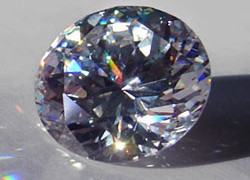 Marketed as the “World’s Best Diamond Simulant,” Russian Brilliants® are another brand of cubic zirconia. Hadar Company, an international diamond company located in San Diego, markets the Russian Brilliant product in addition to their specialty; clarity and color enhanced diamonds.
Marketed as the “World’s Best Diamond Simulant,” Russian Brilliants® are another brand of cubic zirconia. Hadar Company, an international diamond company located in San Diego, markets the Russian Brilliant product in addition to their specialty; clarity and color enhanced diamonds.
Russian Brilliants appear to only be sold online and are available as loose stones and in a variety of jewelry. What does seem to be unique about the Russian Brilliant product is that it available in a wide variety of shapes and colors. In other words, they are not only diamond simulants; they are simulants for tanzanite, ruby, emerald, sapphire, alexandrite, padparadsha, and tsavorite. The last time I checked, the price for all Russian Brilliant stones was $280 per carat.
Other Names
Diagem, Diakon, Dialite, Diamanite, Diamite, Diamogem, Diamonair, Diamonaura, Diamon-brite, Diamone, Diamonesque, Diamonette, Diamonflame, Diamonite, Diamonte, Diamontina, Diamondite, Diamothyst, Diarita, Di’Yag, Djevalite, are all brand names which have or may have been used, and possibly registered trade marks for diamond simulants, or for simulated diamond jewelry. It is possible that many of these names may have been applied at the time to a variety of different diamond simulants, but most often cubic zirconia.
